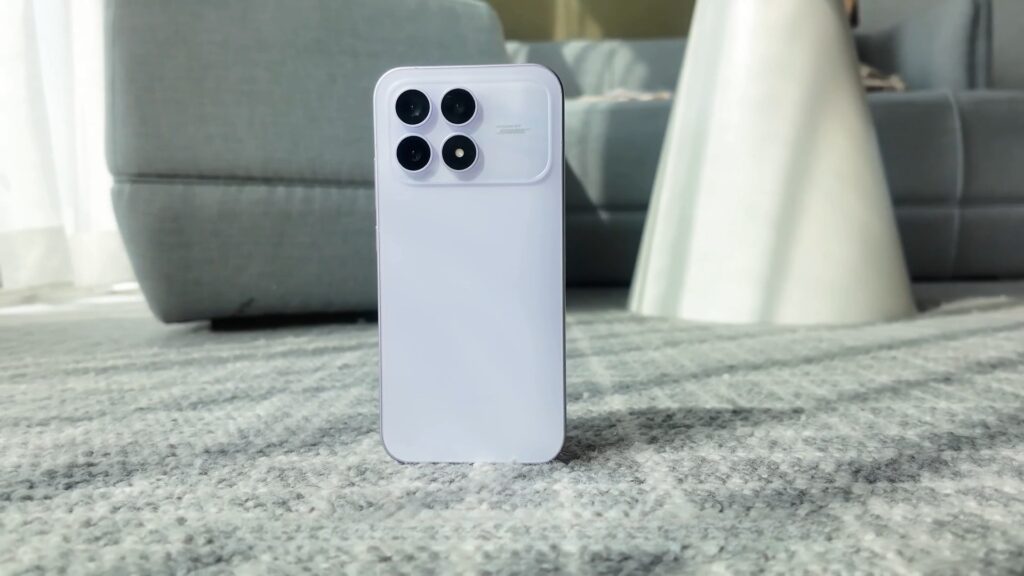I didn’t expect the Redmi K90’s appearance to change so drastically. This level of craftsmanship almost feels unfamiliar. Let’s get to know the Redmi K90.
Design and Ergonomics
As you can clearly see, the biggest change for the Redmi K90 is this deco design. It feels a bit like the previous K70, but the overall design is more rounded. And its curvature is the same as the corners of the phone’s body. I think this design provides better uniformity. This generation uses a one-piece cold-carving process similar to the iPhone’s. The camera deco is cut from the back cover and has a glossy finish. Of course, it will inevitably be prone to fingerprints.
Previous Redmi K-series phones always had various patterns on the back cover. This time, the K90 has pure frosted glass, which feels very delicate to the touch. This phone gives a more premium feel than the previous generation. I feel that if the iPhone 17 Pro Max continued its previous glass design and made it with an effect similar to Redmi’s, it would probably look much better. But I have to say, this separated camera design is indeed not as convenient for wiping clean. There are more corners and edges that need cleaning.
The frame on this generation continues from the last, also made of all-metal, frosted aluminum alloy. The edges have a slight curve, but the transition to the glass still feels a tiny bit sharp. Compared to flagship devices like the Oppo Find X8 Ultra, the detail in the finishing is admittedly a bit rougher. But considering the price, it’s certainly understandable.
Display and Audio
Recent Xiaomi phones have all adopted a large-radius corner design. The advantage is that it gives a noticeable improvement to the overall premium feel, enhancing the craftsmanship.
This time, the screen uses the latest M10 luminescent substrate, consistent with Xiaomi’s newest numbered series. The K90 also uses the same Pro Max-level Super Pixels. The display sharpness on this 6.59-inch screen is still very fine. The screen’s dimming method is full-range DC dimming, which is very comfortable to look at.
This time, the speakers are symmetrical 1115F units, top and bottom. The top also has an opening, so the external sound from the top and bottom won’t be too different. This time, it’s also been co-tuned with Bose. You can have a listen to the actual audio experience.
Performance
We all know that the K-series’ standard processor is usually the previous generation’s flagship chip. This time, it’s the Snapdragon 8 Elite. This chip’s energy efficiency and performance are both excellent. Paired with Redmi’s new three-stage, ice-sealed cooling system, the maximum heat dissipation capacity is 7 watts.
In our tests, Honor of Kings averaged 119.9 frames per second. Genshin Impact averaged 59.9 frames per second. For Honkai: Star Rail, we switched to a more demanding custom map, where it averaged 58.7 frames per second. For Wuthering Waves, we also chose a more demanding area, the Tiger’s Maw, where it averaged 59.2 frames per second. After a year of optimization, the chip’s performance is quite reassuring.
Battery and Charging
Of course, after performance, everyone is concerned about battery life. This time, the battery has been increased by 550mAh compared to the previous generation, reaching 7100mAh, paired with 100W fast charging that supports PPS. Under daily workloads, the battery life can basically be maintained at 7 to 8 hours. I haven’t used it for long enough, so the data might not be very accurate and is just for reference.
Camera Capabilities
Finally, let’s talk about the camera. The Redmi K-series’ camera configuration has never been luxurious, as the budget is spent on performance. This time, the main and ultra-wide cameras remain the same as the previous generation. The overall performance is adequate. You can take a quick look at the photos I took.
But what’s very surprising is that this time, there’s finally a telephoto lens. It has a 2.5x magnification ratio. It’s a 1/2.88-inch OV50M. This sensor is commonly found as the wide-angle camera on major flagships. Having a telephoto versus not having one makes a huge difference. With a telephoto, I can even take photos of airplanes. Even when compared to a camera flagship like the Oppo Find X8 Ultra, I feel that without zooming in, the difference isn’t that significant.
However, this 2.5x telephoto lens has a noticeable jelly effect in the preview screen, which really affects the shooting experience. This jelly effect is, however, not present when recording video. I hope Xiaomi can optimize this further. Overall, this camera’s performance is quite good for its price point. Having a telephoto lens makes it versatile enough for daily life.
Final Thoughts
So, for purchasing advice, this generation of the Redmi K90 is quite a big step up. Whether it’s the exterior design or the newly added telephoto lens, it will enhance the experience for existing K-series users. This is especially true for models from around the K70 generation. The battery in this new device has increased by a lot compared to before. The improvement in battery life after upgrading will be very significant.

